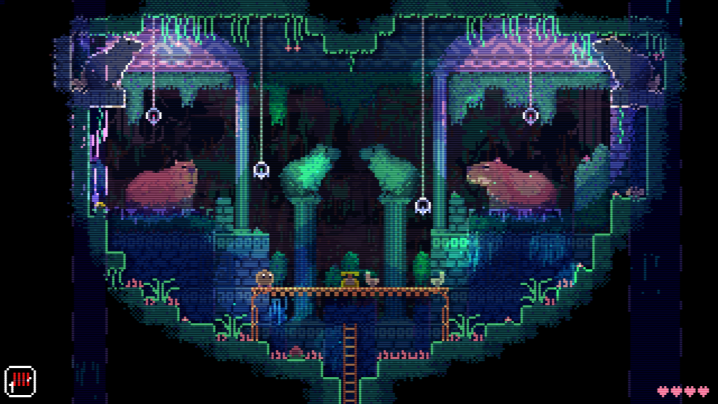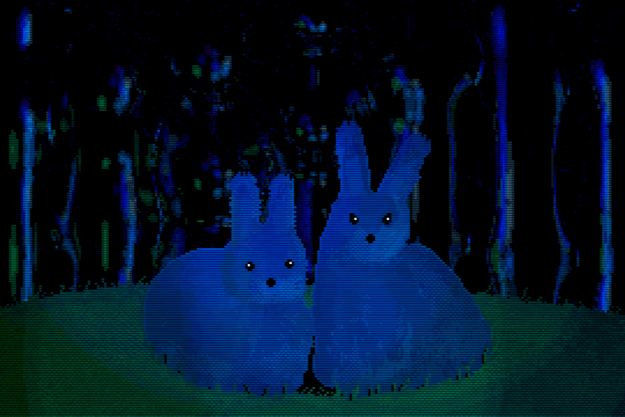
- Strong puzzle platforming
- Creative, multi-use items
- Striking visual style
- Rich with deep secrets
- Demands community engagement
- Backtracking is a pain
When I begin my adventure in Animal Well, I’m not born as a complex mammal. I’m just a blob. I have no special powers that can help me navigate dangerous 2D corridors filled with deadly traps and aggressive animals. I only have the most basic of video game tools to lean on: moving and jumping. If I want to master the world around me, I’ll need to adapt.
Solo developer Billy Basso uses that setup to get to the heart of the Metroidvania subgenre in Animal Well, a terrific 2D platformer packed with mysteries. A truly great Metroidvania turns growth into a powerful hook. Each time players make a new discovery, their understanding of the world around them expands. An unfamiliar maze of rooms and hallways can feel like home by the end of an adventure as players become fluent in the game’s design. Animal Well takes that idea to a logical conclusion, connecting that gameplay idea to the animal kingdom. How does even the simplest of creatures learn how to navigate a complicated world governed by unknowable natural law?
That question transforms Animal Well from an abstract platformer with a striking art style to a deceptively insightful visualization of animal adaptation. Consistently surprising gameplay twists that buck conventions at every turn create an engrossing world that will make players feel like they’re learning and mastering an entirely new language. The only piece that’s yet to be seen is how that experience will play out long term, as some deep mysteries built for a community to solve together might leave solo players lost outside the hive.
A maximalist Atari game
Animal Well is a game that operates in layers, some of which I imagine a lot of players may never even see. Let’s start with the foundation. When the adventure begins, players are born into an empty map and given free rein to explore. Initial markers indicate that there are four flames scattered around the world, but that’s the only guidance the blobby hero ever receives. It’s up to players to scour every corner of the nonlinear 2D map to find those flames, as well as secret eggs, matches that can light darkened rooms, and multipurpose items that gradually open up the way players interact with the world. That quest pairs with some precise platforming and clever environmental puzzle-solving that keep a game with no combat feeling consistently engaging.

The ambitious 2D platformer returns to gaming’s primal instincts, almost playing like a maximalist Atari 2600 game. It has players navigating screen after screen of pixelated obstacles on a mysterious quest that’s never explicitly explained. Knowledge is the most powerful tool of all, as each discovery helps players understand the unspoken language of the peculiar world a little more. Though it’s playing with a popular modern genre, its DNA feels more deeply rooted in 1980s adventure classics like Pitfall. It’s all about entering a new room, encountering a new challenge, and learning how to deal with it through experimentation.
That design idea is most apparent in Animal Well’s approach to items. In many Metroidvania games, each new item that players get comes with a clear use that’s immediately telegraphed by environmental design. That’s not always the case here. When I get one of my first items, a frisbee, I have no idea what it does. I throw it against a wall and see that it can bounce off of surfaces. Later, I launch it into some vines, which stop it in its tracks. I’m slowly learning. Eventually, I have an accidental eureka moment when I jump on it in midair and realize I can ride it once I’ve thrown it. Each of those discoveries naturally changes my understanding of the world around me and how to navigate it without a second of tutorial.
Animal Well’s rooms are packed to the brim with secrets.
That knowledge loop creates a strong exploration hook that encourages me to frequently return to puzzling rooms that I don’t initially figure out how to solve. In one set of screens, I find a series of platforms moving on a conveyor belt that only go up. It feels like there’s a secret below them if I could only reverse their direction. There isn’t a signposted hint like a red door that tells me I need to return later. I could already have what I need in my possession; I just have to experiment to find out. That makes for a less rigid Metroidvania that rewards players for their curiosity at every corner.
And I truly mean every corner. While the initial objective is clear, Animal Well’s rooms are packed to the brim with secrets. One deep quest has me hunting for well-hidden eggs nestled in secret passageways. Some are only accessible after I figure out how to rethink my items and how they interact with one another. I feel I’ve truly evolved when I invent my own transportation method that allows me to find some secrets way earlier than intended. That’s the deceptive power hidden within Animal Well’s seemingly small toolset.
Visual cues
Mastering items is only one small piece of the journey. Animal Well is just as much about understanding the visual language of the world as it is mastering mechanics. At first glance, the platformer’s pixelated art may seem fairly standard for a small-budget indie. That’s another way in which the adventure starts deceptively simple, only to reveal its jaw-dropping depths with each passing hour.
Observation is a superpower in Animal Well.
Basso’s pixel art style feels retro and modern in the same breath. Some pieces call back to the Atari age, with grass and vines represented by a few green lines and dots. There’s a tremendous amount of detail throughout, though. Each 2D room has real depth thanks to layers of overlapping art that make some spaces feel huge. Animal statues line the backdrops alongside dripping water, overgrown plants, and decaying architecture. That’s all accentuated by stark lighting and an atmospheric retro soundscape that’s always dropping unexpected hints.
The painstakingly constructed world isn’t just for show. Learning to read the environment is a key to figuring out all of its secrets. A mosaic of a fish is never just a mosaic of a fish. Chances are that if anything looks uniquely crafted, there’s some kind of secret hidden within it. I don’t think there’s a single room that doesn’t contain some kind of visual secret, whether its a well-hidden cavern, a cipher baked into the environment, or an entirely unexpected twist that may not become apparent until the 20th time you’ve trekked through that room.

Observation is a superpower in Animal Well. Those who are determined enough to pull the world apart like a puzzle will find layer after layer of nuances. Even when I felt like I had seen everything there was to see in a room full of carefully positioned crows or scattered turtle statues, I was still making unexpected discoveries 15 hours into the game that completely changed how I viewed my surroundings. Even now, I’m confident I haven’t seen it all. There are still rooms where I can sense something below the surface waiting to be found. It brings out the animal instinct in me.
Relying on a herd
If it sounds like I’m dancing around some specifics here, that’s because I am. Animal Well’s power hinges on its secrets. The quest for the four flames that I’ve described will get you to the end credits, but it’s a tiny slice of the experience. I reached the first ending in five hours. I’ve played well over 20 since then — and I still feel like I’m miles away from uncovering every mystery.
Basso has previously noted that Animal Well is built on intricate secrets, some of which he expects won’t be discovered for a long time. The goal is for a dedicated community of code crackers to form around the game, working in sync to solve the deepest mysteries (not unlike Tunic). That’s an enticing, if idealistic, vision. Judging by what I’ve played, Animal Well does seem to support it with some true brain-benders that already have me ready to share my notes with a larger player base.
If I had been playing during regular release, I would have just stopped to look up guides …
While ambitious, that idea does come with a dose of reality. I’m sure that a handful of excited players will flock to a Discord server on day one and spend months — if not longer — trading secrets. That will no doubt be a rewarding experience. In fact, I got a taste of it when publisher Bigmode set up a server for reviewers one month before launch where we could trade notes. I made some shocking discoveries by trading screenshots and theories other writers. It’s a reminder that some animals hunt better in packs.
Most people will not experience Animal Well that way, I imagine. This is a single-player game that doesn’t feature any clear indication of how deep the rabbit hole goes. I imagine a lot of people will hit end credits and stop there. That’ll be a shame, because the first layer is inherently unsatisfying. It only begins to tease the lore and what makes everything tick. Those who don’t realize that there’s more to see will feel like they’ve played a stylish, but hollow Metroidvania with some clever traversal ideas.
Anyone who does decide to keep playing through its more complex endgame on their own will quickly hit their limits. I was seemingly ahead of other reviewers during my playthrough for a while, which meant that I got to experience what it was like to try and solve problems on my own before collaborating. That mostly turned into me backtracking through rooms over and over again. Each new item or detail I obtained would send me back through the entire map in search of the few rooms where my new tool was useful. If I had been playing during regular release, I would have just stopped to look up guides at a certain point once someone else had done the heavy lifting. What can I say? Some of us are scavengers.

While the urge to bypass the mental work will be strong, Animal Well is at its best when you trust your own instincts. Doing so will reveal one of the Metroidvania genre’s most arresting adventures, one that trades mechanical genre tropes for genuine mystery and surprise. And once those secrets begin to overwhelm, consider joining the collective cause as an organized ant colony inevitably forms from scattered insects. That’s the final adaptation lying at the center of Animal Well, a game that will perhaps stand in as a metaphor for how a single organism becomes a thriving species. One blob can only do so much, but there’s power in a herd.
Animal Well was tested on PC and Steam Deck.
Editors’ Recommendations
Services Marketplace – Listings, Bookings & Reviews

